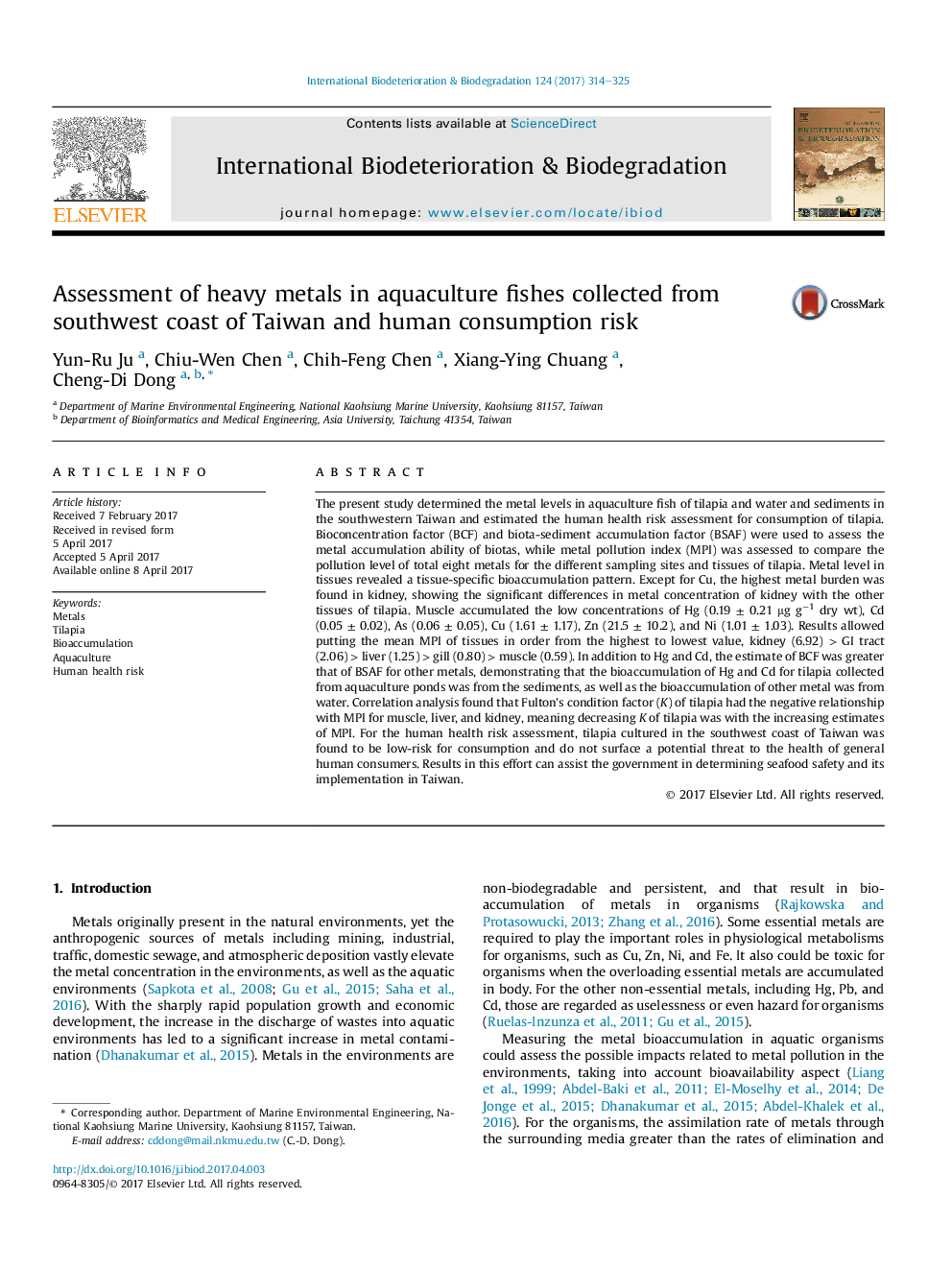| کد مقاله | کد نشریه | سال انتشار | مقاله انگلیسی | نسخه تمام متن |
|---|---|---|---|---|
| 5740349 | 1616293 | 2017 | 12 صفحه PDF | دانلود رایگان |
عنوان انگلیسی مقاله ISI
Assessment of heavy metals in aquaculture fishes collected from southwest coast of Taiwan and human consumption risk
ترجمه فارسی عنوان
ارزیابی فلزات سنگین در ماهی های آبزی پروری جمع آوری شده از ساحل جنوب غربی تایوان و خطر مصرف انسانی
دانلود مقاله + سفارش ترجمه
دانلود مقاله ISI انگلیسی
رایگان برای ایرانیان
کلمات کلیدی
فلزات، تیلاپیا، ذخیره سازی بیولوژیک، آبزی پروری، خطر سلامت انسان،
موضوعات مرتبط
علوم زیستی و بیوفناوری
علوم محیط زیست
علوم زیست محیطی (عمومی)
چکیده انگلیسی
The present study determined the metal levels in aquaculture fish of tilapia and water and sediments in the southwestern Taiwan and estimated the human health risk assessment for consumption of tilapia. Bioconcentration factor (BCF) and biota-sediment accumulation factor (BSAF) were used to assess the metal accumulation ability of biotas, while metal pollution index (MPI) was assessed to compare the pollution level of total eight metals for the different sampling sites and tissues of tilapia. Metal level in tissues revealed a tissue-specific bioaccumulation pattern. Except for Cu, the highest metal burden was found in kidney, showing the significant differences in metal concentration of kidney with the other tissues of tilapia. Muscle accumulated the low concentrations of Hg (0.19 ± 0.21 μg gâ1 dry wt), Cd (0.05 ± 0.02), As (0.06 ± 0.05), Cu (1.61 ± 1.17), Zn (21.5 ± 10.2), and Ni (1.01 ± 1.03). Results allowed putting the mean MPI of tissues in order from the highest to lowest value, kidney (6.92) > GI tract (2.06) > liver (1.25) > gill (0.80) > muscle (0.59). In addition to Hg and Cd, the estimate of BCF was greater that of BSAF for other metals, demonstrating that the bioaccumulation of Hg and Cd for tilapia collected from aquaculture ponds was from the sediments, as well as the bioaccumulation of other metal was from water. Correlation analysis found that Fulton's condition factor (K) of tilapia had the negative relationship with MPI for muscle, liver, and kidney, meaning decreasing K of tilapia was with the increasing estimates of MPI. For the human health risk assessment, tilapia cultured in the southwest coast of Taiwan was found to be low-risk for consumption and do not surface a potential threat to the health of general human consumers. Results in this effort can assist the government in determining seafood safety and its implementation in Taiwan.
ناشر
Database: Elsevier - ScienceDirect (ساینس دایرکت)
Journal: International Biodeterioration & Biodegradation - Volume 124, October 2017, Pages 314-325
Journal: International Biodeterioration & Biodegradation - Volume 124, October 2017, Pages 314-325
نویسندگان
Yun-Ru Ju, Chiu-Wen Chen, Chih-Feng Chen, Xiang-Ying Chuang, Cheng-Di Dong,
